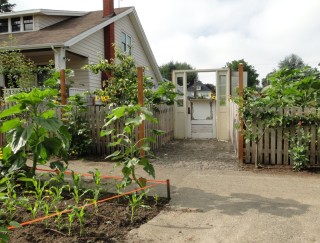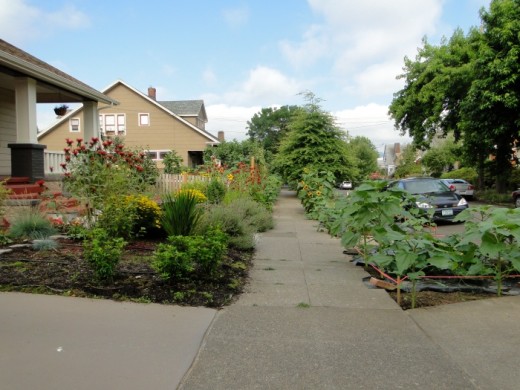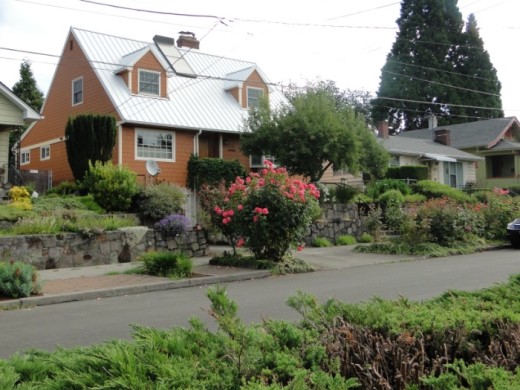Wikipedia Definition:
A road verge, (also verge, boulevard, city grass, devil’s strip, nature strip, parking strip, sidewalk buffer, tree belt, tree lawn, utility strip, parkway, etc.) is a narrow strip of grass or plants and sometimes also trees located between the carriageway (roadway) curb (or road surface edge or shoulder) and the boundary (right-of-way line) of a road.
The land is often public property with maintenance usually being a municipal responsibility; however some municipal authorities require that abutting property owners maintain these areas and also sidewalks.
In Portland, Oregon, it’s technically called the “furnishing zone” (although also referred to as the planting or parking strip) — and throughout the city’s residential neighborhoods you’ll see beautiful, creative examples of what residents have done.
In many cases, they’re wildflowers, in others, they’re small vegetable gardens. But altogether, it’s hard to deny that they enhance their neighborhoods and create a warm, welcoming feel.
OK, but what about those problem property owners who let things get out of hand? How does the city deal with plantings that are unsightly and unkempt?
During my walk through the several neighborhoods in southeast Portland, I asked my companions (four Portland planners) how the city of Portland handles situations like that.
As with sidewalks, I was told, the property owner is responsible for maintenance. If there’s a complaint, the City will respond. The main concern is that people can get out of their car when parking. [View the City’s regulations (pdf) for the furnishing zone and related parts of the public right-of-way]. For planting trees, the City’s Parks & Recreation Department offers detailed guidelines and advice on tree plantings. As the Department notes, permits are required, but free, and include an on-site inspection to “assure the proper tree location and help you select appropriate tree varieties.
 But apparently what’s happening in in the planting strip has not been much of a problem. Maybe it has to do with the streak of individuality, or nonconformity that seems to characterize Portlanders.
But apparently what’s happening in in the planting strip has not been much of a problem. Maybe it has to do with the streak of individuality, or nonconformity that seems to characterize Portlanders.
Or perhaps it’s the relaxed way of life in many Portland neighborhoods (especially the older, street-car era ones), where you’re more likely to hear a bike zip by than a car; where streets are relatively narrow; and where the trees and vegetation provide a lush green backdrop.
Hey, it’s kind of hard to get too irritated living in a neighborhood like that.
I’m curious how your city — and its residents — approaches its furnishing zones, planting strips, tree belts, sidewalk buffers, verges, devil’s strips [I guess for cities where property owners are especially mischievous] or whatever you call them in your community.
Can residents plant in them? Have you had any problems? Take a minute to add a comment below, or join the discussion on our LinkedIn group page.


